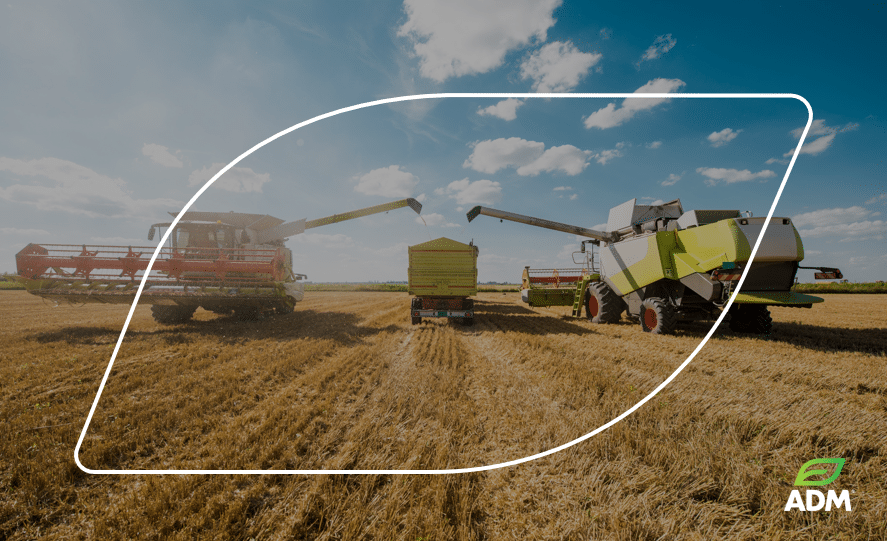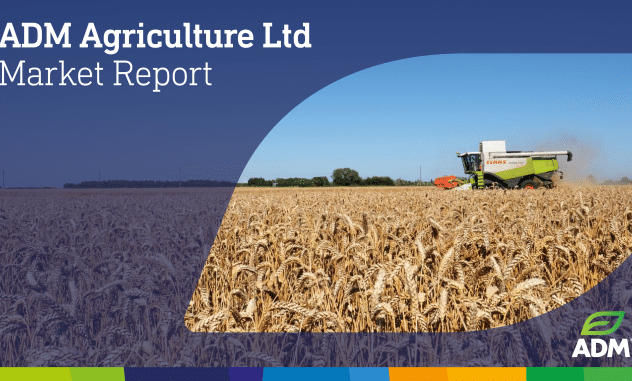WELCOME TO THE ADM AGRICULTURE WEEKLY MARKET REPORT
Wheat
Wheat markets remain volatile following last week’s 60-day extension of the Black Sea grain corridor. Most of the market was expecting a dead stop to the agreement so this U-turn has kept prices on their recent downward trajectory.
CBOT wheat futures are challenging contract lows of $6/bushel, following some small improvements for the winter crop condition, which is up 2% to 31% good/excellent.
US maize prices have appreciated slightly vs wheat due to virtually no rain being forecast in June for key growing states. The crop is now 82% drilled/52% emerged in almost ideal conditions, but fears over a longer-term drought are starting to be priced in.
Cheap maize supplies from South America continue to undercut most other origins with an estimated ninety-five mln t of exportable surplus for the current crop year for Argentina and Brazil. South American maize exports are currently priced at a $10-$20 discount to the US.
Brazil’s safrinha maize harvest is almost underway as hot, dry conditions push crops on in key growing states. A record output is expected, with most estimates tipping over 100 mln t.
Ukraine continues to blame Russian inspectors for holding up vessels from reaching the port in Pivdennyi, one of the three ports designated by the BSGI for the safe passage of Ukrainian grain.
UK carryout remains heavy with fresh export business limited.
The 14-day forecast is for settled dry/warm weather which will push crops towards maturity. Most trade estimates fall within the 15.7-16.3mln t range which if realised would give the UK a huge exportable surplus.
On the demand side, domestic consumers remain relaxed, picking off bits of cover backed by their customers. Exports are still £13-£15/t too expensive, so they are in no rush to cover large runs on feed wheat.
Malting Barley
Old crop malting barley markets continue to disappoint. Buyers are all covered, and values continue to slip as supply is still finding its way to the market.
New crop is starting to pick up a little and, for another week, we see more positive engagement from farmers, although ex-farm sales remain slow and far from where we would like it to be. Meanwhile domestic consumers are totally disengaged for now on new crop.
EU FOB markets are drifting in line with wheat futures, although slow farmer selling across Europe has seen premiums over feed rise over the week.
Feed Barley
There has been a slight change in the feed barley market over the past week, with pockets of spot demand from Ireland and southern Spain from consumers looking to close their old crop books. Consumer demand for old crop in the UK is absent.
New crop is still defined by a lack of farmer selling, but despite this, prices continue to fall in line with wheat futures.
Export demand has quietened down as Spain, the only destination showing any demand, continues to build an import programme out of the Black Sea, which still calculates competitively.
Rapeseed
OSR and the soybean complex has experienced a very two-sided trading story this week after suffering steep declines following up to and beyond the recent grain corridor development story.
Weather was in the focus with dryness across key growing states and even increased likelihood of drought conditions driving sentiment and the market higher mid-week.
Outside markets remain mixed with equities still being buffeted around by debt ceiling negotiation which looks to be prolonged and dragged out. Concern is building in some areas that talks will come to a halt and no resolution will be found, culminating in US government default.
The soy complex managed to stage somewhat of a comeback, trading just off the weekly highs. After trading down to its lowest level since Dec 2021 the market moved sharply higher, with ideas that the market is oversold and looking relatively cheap combined with concerns around weather conditions in Iowa and Illinois. This helped to add some momentum into the market and support prices, although the longevity of this move looks vulnerable as all ag commodities come under pressure.
Energy markets remained stagnant at the start of the week. But suspicions that OPEC will bring in further production cuts sprang the market into life and pushed crude markets higher, adding added support for veg oils.
US soybean exports are down 2% against the yearly average although some significant soymeal business did get done into the Philippines. This fuelled funds, adding to the long position in soybean meal, in contrast to the other elements of the soy complex which have seen a significant outflows recently, with short positions developing from managed money.
Crop plantings in the US are to be announced this week, with the trade expecting near 66% complete as compared with the 49% last week.
Elsewhere, China’s soybean imports from Brazil have fallen further in April compared with the same month last year. The world’s top buyer of soybeans imported 16% less in April from Brazil, its largest supplier.
Prices for palm oil have come under pressure and continue to lose ground in Kuala Lumpur amidst improved weather and news that top importer India is due to see imports fall to a 27-month low.
EU crop-monitoring agency MARS improved its rapeseed future yields estimate to 3.34t/ha compared with the previous estimate of 3.31t/ha last month. This is an increase of 8% compared with the five-year average, which should add further negative sentiment to the market and push prices lower in the long term.
Pulses
Peas
The domestic pea crop looks good. Growers who planted later than usual should see satisfactory results, given the moisture that was in the ground at the beginning of May and the current favourable conditions. Should we get the right weather at flowering through June, we could see an increase in yields by up to 0.5t/ha!
The feed pea market both for old and new crop remains noticeably quiet. Consumers appear covered, which has brought feed pea prices on farm right back due to the lack of demand.
Human consumption pea buybacks for 2024 crop are likely to be released in June.
PGRO has released a particularly useful video for pea growers on managing pea moth, including monitoring pest levels to assess spray thresholds. Watch the video here!
Seed
Over the next month we have several variety trials days across the country, if you would like to attend one of the events, please contact your farm trader.
A range of our countryside stewardship mixes are available for fast delivery including AB9 Wild Bird Seed Mixtures and AB15 Two Year Sown Legume Fallow.
We can also offer our Summer Legume and Summer Thrive cover crop mixtures for fast delivery. Cover crops are a fantastic way to help with soil erosion, control pests/diseases, crowd out weeds and improve the soil condition. In turn, this will help prepare the soils ahead of autumn drilling.
Fertiliser
The UK market has seen the UK AN price issued with greater option on delivery windows. Although availability is more stable than last year, clearly limitations of imported AN and UK AN remain when demand is so strong.
CF remains in one of the strongest positions in the European AN manufacturing space; ammonia importation/port facilities are an asset to CF industries to service the UK and European market.
CF can service circa 25% of the total UK nitrogen market so the UK must still import nitrogen.
ADM continues to import urea and inhibited urea for remaining part of the UK solid nitrogen market. This remains a very viable option in what appears to be a very tight AN market.
The natural gas price in Europe remains higher than when the initial fertiliser production capacity began to be curtailed in September 2021. Forward values in Europe for winter 2023 are almost double current summer contract levels.
Break-Even Ratios for UK farmers are around normal targets once again after 20 months of extreme volatility in both grain and fertiliser markets, which has made farming an even higher risk industry.
Hedging fertiliser purchases with grain sales is a way of market participants reducing risk and encouraged when opportunities arise.
PK prices remain stable-weak, but nitrogen has taken the attention this week in the UK.
| £/€ | £/$ | €/$ |
|---|---|---|
| 1.15 | 1.24 | 1.07 |
| Feed Barley £ | Wheat £ | Beans £ | Oilseed Rape £ | |
|---|---|---|---|---|
| May 2023 | 150-160 | 167-177 | 230-235 | 341-346 |
NB: Prices quoted are indicative only at the time of going to press and subject to location and quality.
“Although ADM Agriculture take steps to ensure the validity of all information contained within the ADM Agriculture Market Report, it makes no warranty as to the accuracy or completeness of such information. ADM Agriculture will have no liability or responsibility for the information or any action or failure to act based upon such information.”
ADM Agriculture cannot accept liability arising from errors or omissions in this publication.
ADM Agriculture trade under AIC contracts which incorporate the arbitration clause.
Terms and Conditions of Purchase.
On every occasion, without exception, grain and pulses will be bought by incorporating by reference the terms & conditions of the AIC No.1 Grain and Peas or Beans contract applicable on the date of the transaction. Also, we will always, and without exception, buy oilseed rape and linseed by incorporating by reference the terms & conditions of the respective terms of the FOSFA 26A and the FOSFA 9A contracts applicable on the date of the transaction. It is a condition of all such transactions that the seller is deemed to know, accept and understand the terms and conditions of each of the above contracts.


